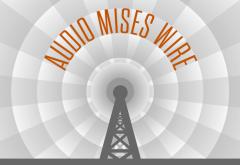Capitalism vs. Freedom: The Toll Road to Serfdom by Rob Larson Zero Books, 2018, 233 pp. Rob Larson, who is a professor of economics at Tacoma Community College in Washington, does not agree with Mises, Hayek, Rothbard, and Friedman that the free market promotes freedom and prosperity and that socialism is the “road to serfdom.” That is an understatement, and you won’t find any understatements in this book. To the contrary, the book abounds in wild accusations. For Larson, the eminent economists just mentioned are more than mistaken: they are criminal deceivers. His principal targets are Friedman and Hayek, but Mises and Rothbard are not spared. He says, This consistent pattern reveals that a number of quite respected Nobel Prize–winning conservative economists,
Topics:
David Gordon considers the following as important: 6b) Mises.org, Featured, newsletter
This could be interesting, too:
Nachrichten Ticker - www.finanzen.ch writes Die Performance der Kryptowährungen in KW 9: Das hat sich bei Bitcoin, Ether & Co. getan
Nachrichten Ticker - www.finanzen.ch writes Wer verbirgt sich hinter der Ethereum-Technologie?
Martin Hartmann writes Eine Analyse nach den Lehren von Milton Friedman
Marc Chandler writes March 2025 Monthly
 Capitalism vs. Freedom: The Toll Road to Serfdom
Capitalism vs. Freedom: The Toll Road to Serfdom
by Rob Larson
Zero Books, 2018, 233 pp.
Rob Larson, who is a professor of economics at Tacoma Community College in Washington, does not agree with Mises, Hayek, Rothbard, and Friedman that the free market promotes freedom and prosperity and that socialism is the “road to serfdom.” That is an understatement, and you won’t find any understatements in this book. To the contrary, the book abounds in wild accusations.
For Larson, the eminent economists just mentioned are more than mistaken: they are criminal deceivers. His principal targets are Friedman and Hayek, but Mises and Rothbard are not spared. He says,
This consistent pattern reveals that a number of quite respected Nobel Prize–winning conservative economists, including Friedman and Hayek, are intellectual opportunists. By coincidence, their analysis has bottomless contempt for organized labor … but the giant crimes of the enormous greater power of organized capital are studiously ignored. This puts Friedman and Hayek closer to other figures who have used their formidable intellects to defend other cruel power systems. (p. 48. All references are to the Amazon Kindle edition.)
Faced with terrible people like this, there is no need to read them carefully. Why waste your time doing so on intellectual criminals? And Larson does not waste his time. He says, “But more than Friedman and even more than Rand, the bar for capitalist worship was set by Ludwig von Mises, who is conceived to be the founder [sic] of the highly conservative Austrian school of economics, to which Hayek and Rothbard belong. Mises wrote about the ‘creative genius’ of wealthy entrepreneurs” (pp. 13–14). Larson then quotes a passage from Human Action about the “creative genius,” but Mises is not talking there about entrepreneurs but of people like Beethoven who are so driven by the urge to create that they never stop working. More generally, I don’t think that Larson knows much about the Austrian school, and I suspect Menger, Böhm-Bawerk, and Wieser would agree with me.
Even if he doesn’t, though, his main thesis is worth considering. He says, in effect, “Defenders of the market like Friedman claim that it frees people from arbitrary power. Competing firms block exploitation; if a firm paid a worker below what he was worth, other firms would offer more. Friedman contrasts the market with central planning, where everyone must conform or else. What this ignores is that capitalism isn’t run by small, competing firms but dominated by gigantic corporations that rule us.”
To his credit, Larson recognizes an answer to his complaint: “Each case is unique in its details and in many cases the right-wing view of this issue, based on ‘crony capitalism,’ is relevant. Crony capitalism describes a nominal market economy, but one with monopoly, oligopoly or other concentrated structures, because industries were put in the hands of allies or ‘cronies’ of the state regime” (p. 125). But if defenders of the free market say that they don’t favor crony capitalism and are thus immune to Larson’s accusation that they “ignore the giant crimes of organized capital,” they are intellectual opportunists. “[A]ll historical evidence shows that capital concentrates with economic growth and monopolies arise in free-market settings, quite consistently” (p. 126).
I hope that you noticed the key word in the last quotation: “historical.” Larson offers no theoretical account that the free market leads inevitably to monopoly. He mentions economies of scale, network effects, and other factors that tend to increase the size of firms, but he presents no argument that these factors tend always or even for the most part to result in control of an industry by large firms. To the contrary, he simply describes large companies like Amazon and Walmart and wrings his hands in horror.
Another problem escapes Larson’s attention, owing to his ignorance of the Austrian school. His challenge to Friedman is that much of the economy doesn’t consist of a large number of very small firms. In the Austrian view, though, an abundance of small firms, each without significant influence on the market price, isn’t required for competition. All firms, large and small, compete for the consumers’ “dollar votes,” and the market prices that result from this process aren’t judged by the artificial standards of the perfect competition model.
Larson doesn’t like the “dollar votes” idea either. He objects that the wealthy have more votes than the poor. Larson quotes “radical Left economist Robin Hahnel”: “‘It is not one person one vote but one dollar one vote in the market place…. Few would hold up as a paragon of freedom a political election in which some were permitted to vote thousands of times and others were permitted to vote only once, or not at all.’ But this is exactly the kind of freedom the market provides” (p. 24). What this complaint overlooks is that, unlike in political elections, there aren’t just one or a few winners, and even if the rich have more votes than the poor, this does not entail that only the commodities that they want will be produced. Everyone can be satisfied, so long as there is sufficient demand for a product to make it profitable to make it available. Furthermore, one of the points Larson most stresses tells against his criticism of consumer sovereignty. He again and again emphasizes that the rich are a small minority; but if that is true, the poor are in the majority and their dollars votes “add up.” As Mises often says, “capitalism is mass production for the masses.”
Suppose, though, that all my criticisms so far of Larson are wrong and that the free market is a terrible system that exploits the poor. We still need to ask him what he wants to put in its place. His answer once more suffers from his unwillingness or inability to deal with Austrian economics. In response to Hayek, who argued that central planning is a “road to serfdom,” he says that his brand of socialism isn’t based on central planning. Instead, it features democratic control by workers. “But of course a decent standard of living requires a great deal of coordination with other workplaces, to keep necessary goods and services flowing through their often long production chains in a reasonably efficient fashion. This communication across industries is enormously helped by today’s sophisticated telecommunications technology, which could also allow different workforces to collaborate together to satisfy an agreed-upon plan” (p. 194).
How are the workers supposed to do this? Larson offers no discussion at all of Mises’s fundamental point that economic calculation in a complex modern economy can take place only though market prices, and that without such prices the economy would collapse into chaos. Conferences among workers, even those equipped with the latest “telecommunications technology,” won’t solve the calculation problem.
Larson thinks that the critics of socialism have wrongly concentrated on central planning, but if he reads Mises’s account of syndicalism in Socialism, he will discover that Mises is well aware of proposals of the type he favors. I’m reluctant to recommend that Larson do this, though, because he seems unable to read Mises without distortion, and I’ll conclude with one more instance of this. Quoting a passage from The Anti-capitalistic Mentality, Larson says that “Mises attributed socialist movements to emotions of envy and resentment” (p. 195). If you look up the passage, it turns out that Mises is talking about the worker who feel dissatisfied because of people “who have succeeded where he failed,” not the socialist movement. Evidently, accurate quotation isn’t needed when dealing with an “intellectual opportunist” like Mises.
Tags: Featured,newsletter







